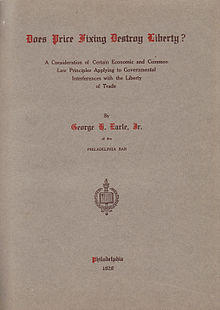
Back Samespanning Afrikaans تحديد الأسعار Arabic Prisaftale Danish Preisabsprache German Fiksa prezo Esperanto תיאום מחירים HE Verðsamráð Icelandic 価格操作 Japanese 가격 협정 Korean Prijsafspraak Dutch
| Competition law |
|---|
 |
| Basic concepts |
| Anti-competitive practices |
| Enforcement authorities and organizations |

Price fixing is an anticompetitive agreement between participants on the same side in a market to buy or sell a product, service, or commodity only at a fixed price, or maintain the market conditions such that the price is maintained at a given level by controlling supply and demand.
The intent of price fixing may be to push the price of a product as high as possible, generally leading to profits for all sellers but may also have the goal to fix, peg, discount, or stabilize prices. The defining characteristic of price fixing is any agreement regarding price, whether expressed or implied.
Price fixing requires a conspiracy between sellers or buyers. The purpose is to coordinate pricing for mutual benefit of the traders. For example, manufacturers and retailers may conspire to sell at a common "retail" price; set a common minimum sales price, where sellers agree not to discount the sales price below the agreed-to minimum price; buy the product from a supplier at a specified maximum price; adhere to a price book or list price; engage in cooperative price advertising; standardize financial credit terms offered to purchasers; use uniform trade-in allowances; limit discounts; discontinue a free service or fix the price of one component of an overall service; adhere uniformly to previously announced prices and terms of sale; establish uniform costs and markups; impose mandatory surcharges; purposefully reduce output or sales in order to charge higher prices; or purposefully share or pool markets, territories, or customers.
Price fixing is permitted in some markets but not others; where allowed, it is often known as resale price maintenance or retail price maintenance.
Not all similar prices or price changes at the same time are price fixing. These situations are often normal market phenomena. For example, the price of agricultural products such as wheat basically do not differ too much, because such agricultural products have no characteristics and are essentially the same, and their price will only change slightly at the same time. If a natural disaster occurs, the price of all affected wheat will rise at the same time. And the increase in consumer demand may also cause the prices of products with limited supply to rise at the same time.[1]
In neo-classical economics, price fixing is inefficient. The anti-competitive agreement by producers to fix prices above the market price transfers some of the consumer surplus to those producers and also results in a deadweight loss.
International price fixing by private entities can be prosecuted under the antitrust laws of many countries. Examples of prosecuted international cartels are those that controlled the prices and output of lysine, citric acid, graphite electrodes, and bulk vitamins.[2]
- ^ "Price Fixing". ftc.gov. Federal Trade Commission. Retrieved January 20, 2023.
- ^ Connor, John M. (April 2004). Extraterritoriality of the Sherman Act and Deterrence of Private International Cartels (Report). American Agricultural Economics Association. Retrieved September 30, 2014.
© MMXXIII Rich X Search. We shall prevail. All rights reserved. Rich X Search